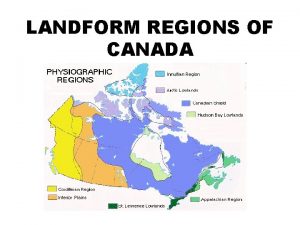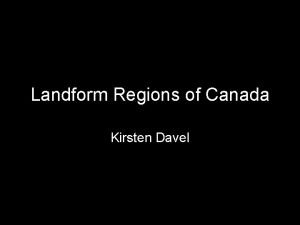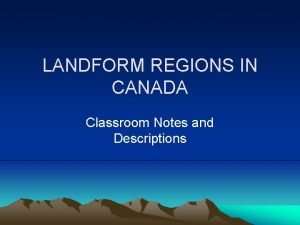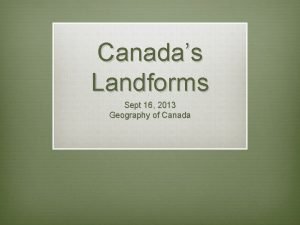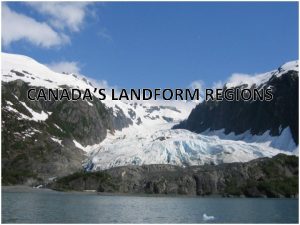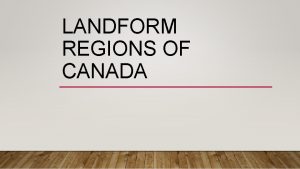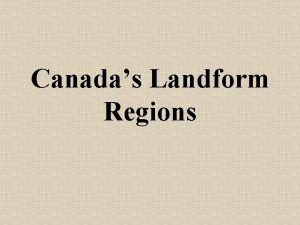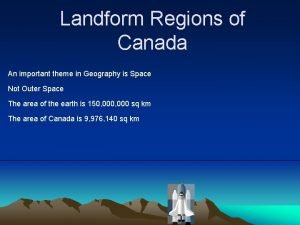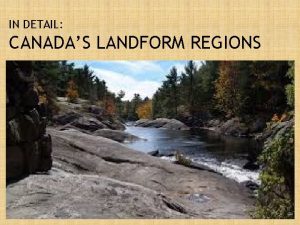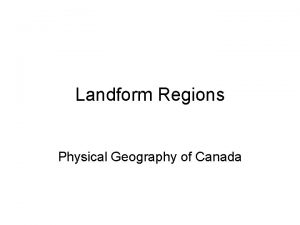LANDFORM REGIONS OF CANADA LANDFORM TYPES There are








- Slides: 8

LANDFORM REGIONS OF CANADA

LANDFORM TYPES • There are many forms of land features that span across North American from vast mountains to plateaus to islands and lowlands. • Canada has 5 major landform regions: • These are: • The Rocky Mountains • The Pacific Ranges (Mountain Ranges) • The Interior Plains/Lowlands • The Canadian Shield • The Appalachian Highlands.

PACIFIC RANGES/COAST MTNS • Most active earthquake region on the continent due to the heavy Pacific tectonic plate sinking below and pushing the lighter NA plate causing magma to flow to the surface and form igneous and metamorphic rocks that are pushed to the surface and form the Coast mountains. • The plates are moving at a speed of 2 -10 cm per year. • In the past 80 years the Geological survey of Canada has recorded 100+ earthquakes of magnitude of 5 or greater under the Pacific Ocean under Vancouver Isld.

ROCKY MOUNTAINS • Great height and ridged means they are relatively geographically young (not eroded) • Run N/S causing transport issues, there are only a few gaps/passes to allow rail or highways to travel E/W through the area. • Areas like Banff and Jasper thrive due to tourism • The glaciers in this area are the only glaciers left in NA other

INTERIOR PLAINS/LOWLANDS • Subject to glaciation, produced a rounded, gently rolling landscape. Was often covered by shallow inland seas-meltwater is now southern MB and SK • Sediments from the Western Cordillera and Canadian Shield were deposited in these inland seas and over time turned into the oil and gas found in AB/SK. • Thick mineral deposits left over from the dried-out sea beds, covered over by sediments, created the potash that is now mined in SK. • Swamps on the outer edges produced plants that eventually changed into coal that is mined today. • The soil that developed on these sediments is deep and fertile for the growing

THE CANADIAN SHIELD • Underlies much of Canada- more than half of Canada! • Some of the worlds oldest rocks • Relatively flat with rounded hills which are actually the roots of ancient mountains. • Mining: Igneous and metamorphic rocks which contain valuable minerals in great quantities such as lead, gold, nickel, copper, zinc etc. It is considered the storehouse of Canada’s Metallic mineral wealth. (Industry) • And Diamonds where volcanoes use to exist deep beneath the earths crust!

THE CANADIAN SHIELD CONT. • Farming: Ill suited for farming due to its thin soils • Recreation/Tourism: Ideal due to its scenic rivers, waterfalls, lakes, rock outcrops and vast forests. (Lake of the Woods!) • 1, 000’s of lakes in this area were produced due to glacial ice scraping and gouging of the land. • Formed as a saucer around Hudson’s Bay, rivers flow towards it allowing many Hydro dams to be build here.

APPALACHIAN HIGHLANDS • Stretch from the Maritimes (Nfld) to Georgia USA, and are the oldest highland region in NA formed about 300 million years ago. • During the formation of Pangea sedimentary layers were uplifted and folded when the NA plate collided with the Europe and Africa plates. • Rocks found in NS and Nfld are similar to rocks found in Wales and Scotland. • Millions of years of erosion has reduced the once jagged peaks into rolling mountains and hills with a ‘drowned coastline’ with rich fertile river valleys along the sea coast.
